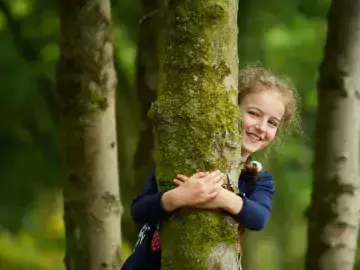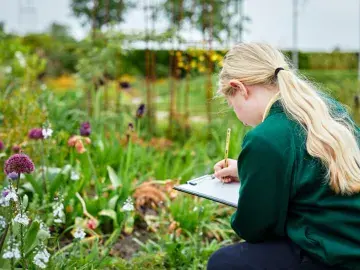
Habitats: Mapping hedges and bushes
Mapping hedges and bushes is part of the Mapping your site activities, enabling you to explore and map the habitats your site currently offers for nature. Understanding your starting point is really important and will allow you to measure any nature gains you achieve when you start making enhancements to your site. Mapping hedges and bushes is one of eight habitat mapping sessions in this unit of learning.
Before mapping any hedges or bushes, the introductory activities have been designed to support learners in identifying types of hedges and bushes, allowing them to answer the questions in the Hedges and Bushes Habitat Flowchart accurately.
These activities can also be used as standalone activities, promoting a positive connection with nature. They can all be found as pdf and powerpoint downloads below.
You can carry out this activity in Spring, Summer and Autumn.
Getting to know your space
Preparation
Green skills
- identification and ecology
- recording data
- interpreting data
What you need
- tree, hedge, shrub and heathland statements I NOSE activity
- native and non-native shrub Top Trump cards activity
- wildlife-friendly bushes and shrubs proportion activity
- Hedges and Bushes habitat flowchart
- clipboards
- drawing materials
- a tablet, laptop, or desktop PC to access the online Habitat Mapper tool
- a printed map of your site, if you do not intend to use the Habitat Mapper outdoors
Location
Outdoors
Useful guidance
Step by step
I NOSE Trees, hedges, shrubs and heathlands
The purpose of this activity is to support learners to appreciate the distinction between trees, shrubs, hedges and heathlands.
- Seven clues about one of the four habitat features (trees, shrubs, hedges or heathlands) are read out slowly.
- If and when the learners think they know the answer, they place their finger on their nose, identifying ‘INOSE’!
- If a subsequent clue makes them unsure, they remove their finger from their nose.
- Start with more difficult, general clues, and make them gradually more obvious.
- Repeat with the other features.
Support and extension
- For younger learners, you may wish to display an image of each of the four features (even better if they are images from your own school grounds)
- Extend this activity by going out into the school grounds to spot these features
- Learners might enjoy drawing each feature as you read out the statements
Shrubs Top Trumps
Top Trumps is an effective way to help learners compare items. In this version of top trumps, learners can compare shrubs by how ‘wildlife-friendly’ they are.
- Begin by discussing what the term ‘wildlife-friendly’ means. Support learners by highlighting how different plants can provide shelter, protection from predators, food in terms of leaf foliage, flowers (pollen and nectar) and fruits, nuts and seeds.
- Learners can either work in pairs (or teams to save printing) to compare and rank each category out of 10 depending on which shrub is most wildlife-friendly. This part of the activity should take no more than 10 minutes.
- The pairs / teams can then share out the top trump cards and play:
The first person chooses a category on the card at the top of their pile, e.g. tasty leaves. If their card has a higher score than their opponent, they ‘win’ their opponent’s card. If it is less, they give their card to their opponent.
Players take turns until one player has won all of the cards. - While all shrubs support wildlife, this activity can be used to help learners identify important wildlife-friendly shrubs. For example, all of the native shrubs in the top-trump game can be identified as ‘important’ wildlife-friendly shrubs.
Hedges and shrubs habitat flowchart
- Now head outdoors to a space on your site that has hedges or bushes.
- Encourage learners to use the flowchart, and the knowledge they have developed through the I NOSE and Top Trumps activities, to follow the flowchart and identify the hedge and bush habitats. Use the below wildlife-friendly shrub proportions activity if learners need help determining proportions or percentages.
- On the Habitat Mapper tool, or a printed map of your site, educators and learners work together to draw on these areas of habitat.
- Repeat the flowchart for each separate area of hedges or bushes on your site, until you have mapped them all.
- If you used a printed map, transfer it all to the Nature Park map using the Habitat Mapper tool back in the classroom. This is a really important step to ensure your site and your observations are part of national community science research.
- Return to the Mapping your site page and select the next habitat category you have on site.
Wildlife-friendly bushes and shrub proportions activity
Why not use shrubs as a resource for learning about proportions? This simple 5-minute activity challenges your learners to identify the proportion of their sample that is wildlife-friendly.
- Remind learners of the term ‘wildlife-friendly’ from the top trumps activity. Ask the learners what clues they might look for to identify whether a shrub is wildlife-friendly (broad leaves, flowers, fruits, nuts, foliage for shelter).
- Ask the learners to think about how they might divide up their sample into ten parts (e.g. if there are five equal sized shrubs, they would have ten half shrubs).
- Learners can then shade in the proportion of the shrub sample that has wildlife-friendly shrubs.
Reflection
Encourage students to reflect on the types of shrubs they discovered and consider how these plants can benefit both wildlife and people. Think about aspects such as acting as a windbreak, providing habitats, reducing noise and pollution, offering shade, serving as a food source, or serving as nesting places.
Discuss how human activities, like the timing of hedge trimming, could impact these benefits. Explore potential ways to enhance the hedge and shrub environments on their site.
What to try next
Add other habitats to your Nature Park map

Mapping tree habitats
Begin activity
Habitats: Mapping flowers and food
Begin activity